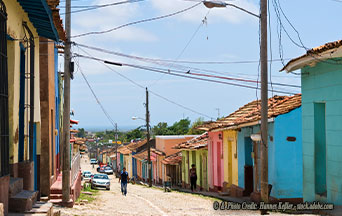
The ongoing collapse of the Cuban electrical grid is not a typical power outage that most countries experience but the result of decades-long systemic neglect, underinvestment and reliance on obsolete technologies.
Most Cuban power plants were built in the seventies and were expected to last 20 or 30 years. However, they are long overdue for maintenance and replacement after years of breakdowns and diminished efficiency.
Why America Must Reject Isolationism and Its Dangers
The grid cannot be overhauled for many reasons, including economic and logistical challenges. Thanks to the Cuban communist regime’s long-standing mismanagement and corruption, the nation is bereft of the resources, skills and outside help needed to rebuild the energy sector. International aid will be insufficient to address the magnitude of the problem, and the regime’s isolation further complicates any recovery processes.
However, the consequences of these blackouts go far beyond supplying power. Cuba’s electric grid failure symbolizes the overall breakdown of the communist state infrastructure. Without electricity, the whole society breaks down. Millions of Cubans are left to fend for themselves without water, communication or transportation that requires electricity.
To give some perspective on how primitive Cuba’s electrical system is, a comparison is fitting. The U.S. used 12,497 kilowatt-hours per capita in 2023, and Cuba used 178 kilowatt-hours per capita, which is 1.4 percent by comparison.
Thus, a massive humanitarian disaster is on the horizon as Cubans are left in a pre-industrial purgatory with no end in sight. Cuba plunges into a protracted crisis of its own making due to its communist ideology.
As the electrical crisis reached an all-time high, myriad other problems are piling up. There is an unwillingness to upgrade technology and a declining position on the world stage due to its human rights violations and suppression of protests.
How could an entire country lose power?
This crisis was caused when the Antonio Guiteras power plant dropped off the grid. The breakdown coincided with the fact that seven of the eight functioning thermoelectric plants were already inoperative or in maintenance mode. The fall of the Guiteras plant plunged the island into darkness. Since then, the grid has partially or fully collapsed several times.
Eternal and Natural Law: The Foundation of Morals and Law
President Miguel Díaz-Canel blamed the high demand for electricity, poorly maintained facilities, a fuel shortage and strict U.S. sanctions.
Most of the reasons are entirely false. Cuba has very few manufacturing facilities, which could create a debilitating high demand. The claim that U.S. sanctions played a role is pure communist propaganda. Cuba is free to trade with the entire world outside the United States. It could easily obtain materials to maintain Cuba’s grid properly.
It is true, however, that fuel is scarce, and the communist government has little money to buy fuel. Thus, the situation will only deteriorate.
Why is Cuba’s energy issue so serious?
The nation could have easily avoided this crisis if Cubans had fought to extinguish socialism and allowed a free-market economy to flourish. Thus, communism is the real culprit chastising Cuba.
During the Soviet era, Cuba traded sugar for Russian oil. However, when communism collapsed in 1991, Cuba lost its cheap oil supply. It plummeted into economic chaos until comrade Hugo Chávez provided cheap Venezuelan oil in return for poor Cuban medical services. The left-leaning Mexican government also sent cheap oil to Cuba but has now cut back.
Today, these sources no longer exist. Russia is sinking daily in the Ukrainian conflict, while Venezuela faces its own set of self-induced injuries. Russia, Venezuela and Mexico continue to send some oil to prop up Cuba, but nowhere near enough to meet the island’s meager needs.
 Learn All About the Prophecies of Our Lady of Good Success About Our Times
Learn All About the Prophecies of Our Lady of Good Success About Our Times
Cuba must resort to the open market without subsidized fuel, which sells at a far greater price, further depleting the prison island’s meager coffers. Cuban export volumes are thin, and its foreign currency reserves are even thinner. Adding insult to injury, Cuba’s lucrative tourism industry has fallen sharply due to the tightening of U.S. sanctions under the Trump administration and COVID-19 pandemic travel bans that kept tourists away and who have not come back.
The government insists that no Cuban protests be held. Cuban President Díaz-Canel said any demonstrations would be subject to the full weight of revolutionary laws.
Unable to protest in Cuba, many residents are protesting with their feet. The recent crisis has accelerated an even greater exodus, with an estimated one million fleeing the “paradise of communist Cuba” in the last three years. This represents the largest rate of flight in Cuba’s history. Those who hope for the future are leaving behind the old and very young.
Perhaps these blackouts could spark political shifts or even incite a mass uprising. Only time will tell. The present crisis makes the real solution more evident. Cuba will never be freed from its misery until communism is extinguished and a Christian order is restored.
Photo Credit: © Hannes Keßler – stock.adobe.com

